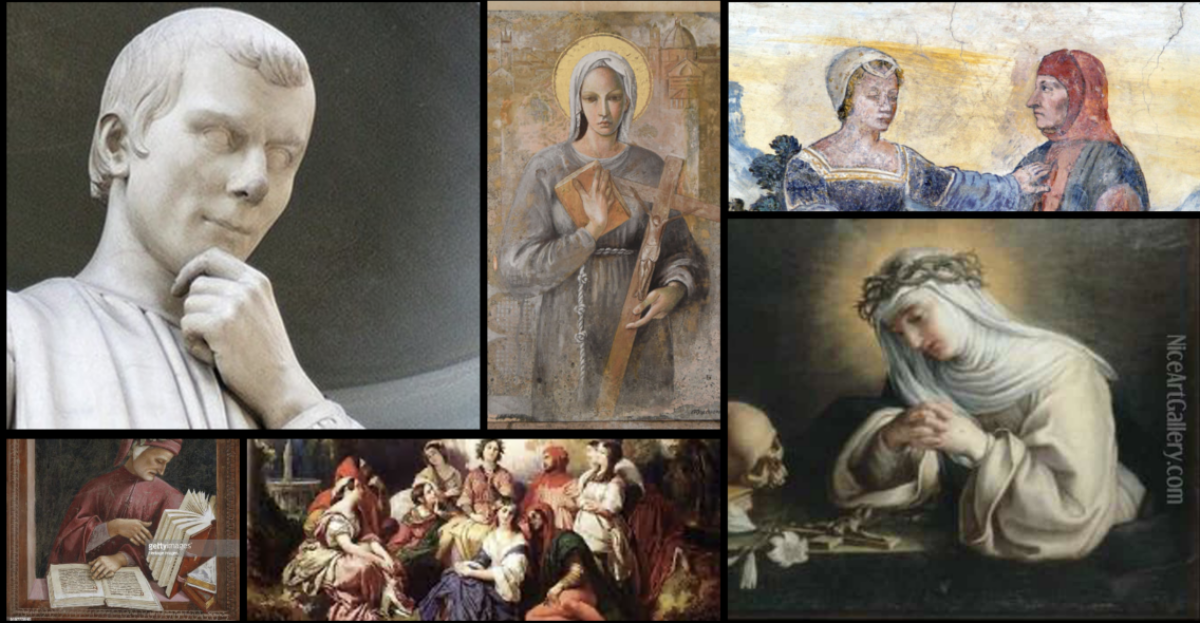In Giovanni Boccaccio’s, “The Decameron” there were a wide range of meaningful themes, messages and topics that are very impactful. The one theme I was most intrigued by was the use of physical violence throughout the stories. Physical violence was a tactic that was greatly used by many characters involved in the stories.
In Day 4, story 4 the physical violence is associated with men’s natural sexual rivalry for women. The story is told by Elissia, in the story Gerbino the grandson of King William II of Sicily who is not only a famous warrior but a man of chivalry falls for the daughter of the King of Tunis. They fall in love without ever being in each other’s sight due to this Gerbino gets a friend to be his messenger that will help the two exchange love letters and gifts back and forth from the lovers traveling from Sicily to Tunis. The long distance love remains until the King of Tunis makes the announcement that he will be marrying her off to the King of Granada. He is aware of the love affair the two lovers are currently having of which he does not approve of causing him to reach out to King William. He is promised that Gerbino will not interfere, but of course Gerbino has other plans. He takes two ships full of men and attends to his lover’s bridal entourage with intentions of capturing her. Unluckily, his unwanted presence and interruption leads the Tunisians to kill Gerbino’s lover right before his eyes. As a result Gerbino breaks out into ultimate physical violence and rage being the warrior he is, he and his men begin to fight and kill. Day 4, story 4 states, “Just like a starving lion who falls upon a herd of bullocks, slashing this one with his teeth and that one with his claws, intent on satisfying his anger rather than his hunger, so Gerbino, sword in hand, cut down one Saracen and then another, slaughtering a host of them without mercy.” Many of Gerbino’s men died and so did many of the others, as a result Gerbino’s grandfather had Gerbino beheaded before his eyes.
Another instance in which Physical violence is presented is Day 2, story 1 which is illustrated by Neifile. In the story Arrigo a poor laborer in Trevisa who is believed to be a saint by the people dies, after his death a variety of miraculous things occur which was a way of confirming this belief to the people. Many want to come into contact with his body to either cure an illness or win favor with him. Three entertainers from Florence , Stecchi, Martellino and Marchese happen to show up in town during this exciting time. They wanted to come into contact with Arrigo’s body for themselves but the crowd was way too big to get by so they came up with a scheme. Martellino pretends to be a paralyzed man who needs the healing powers of the saint, it works and they get through the crowds. The men surrounding Arrigo’s body lift Martellino up and lay him across the corpse, he then pretends as if he has been cured. Unfortunately there’s another Florentine in the crowd who recognizes him and reveals the sacrilege to the crowd, after this the mood automatically alters. The crowd becomes angry and starters to beat him up they are even on the verge of hanging him for mocking the saint. Day 2 story 1 states, “they grabbed him {Martinello} and dragged him down from where he was standing. Holding him by the hair, they tore all the clothes off his back and started punching and kicking him. … Although he did his best to defend himself, it was no use, and the crowd on top of him just kept getting bigger and bigger.” Marchese and Stecchi get the watchman to keep the crowd from killing Martellino, they claim that Martellino had “cut their purses” so that the watchman will save his life by taking him into custody. Other men claim he did the same to them, and were told to say when and where the events occurred but they all chose days he was not in the city. The magistrate has a grudge against Florentines and is tempted to hang Martellino just for fun. While Marchese and Stecchi go back to their lodgings and ask the landlord to help them, who sends them to Sandro, a Florentine living in Trevisa. Sandro takes them to the prince. The prince is amused by the situation but he does go to the magistrate and saves Martellino. The three men then safely return to Florence in the new set of clothing given to them by the prince.
Furthermore, the stories are similar in such that they both show how the characters reckless actions lead to very negative outcomes. It can clearly be concluded that physical violence played a great role in life at the time. Seemingly Boccaccio’s view of physical violence remains somewhat unclear but he does present it greatly throughout the stories which reflects the gruesome role in how physical violence was the main way to discipline and approach issues.
Citations:
Decameron Web | Texts. (n.d.). The Decameron: Day 4, Story 4
https://www.brown.edu/Departments/Italian_Studies/dweb/texts/DecShowText.php?myID=nov0404&lang=eng
Decameron Web | Texts. (n.d.). The Decameron: Day 2, Story 1.
https://www.brown.edu/Departments/Italian_Studies/dweb/texts/DecShowText.php?myID=nov0201&lang=eng




The choice of dealing with two stories we haven’t read in class should be justified here. How did you get to them? I assume you read about them somewhere, another text that inspired you to read them. This text, whatever it is, should be included in the post.
This picture is great!